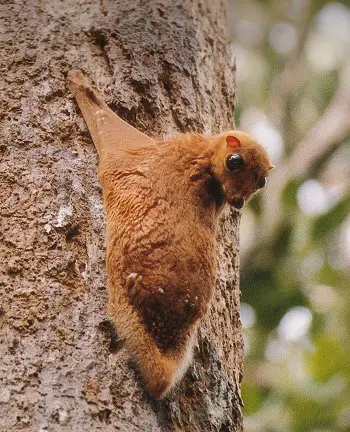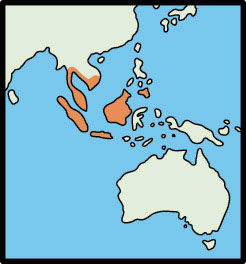THE ORDER DERMOPTERA
Dermoptera – Skin Winged Mammals (2 Species)
Only two living species, in a single genus, compose the entire order of flying lemurs. One species is found in the Philippines; the other from southeast Asia to Java and Borneo. Their scientific name, Dermoptera, means “skin-winged.” They do not have true wings but have the most complete gliding membrane: a furred skin extending from behind the ears outward to the digits, embracing the tail, stretching along the sides and base of the body. This membrane enables flying lemurs to glide up to 150 yards (one and one-half football fields long). They are among the largest of all gliding mammals.

Flying lemurs, or colugos, most probably evolved from ancient insectivores. Indeed, because of their apparent close relationship, colugos were once placed in the order Insectivora. They have also been classified as bats, but could also possibly be an offshoot of the primate family like their lemur namesakes. They are about the size of a domestic cat, and their large eyes and pointed face lend them a certain resemblance to lemurs.
So highly specialized are colugos to their life in the treetops (they have long, curved, sharp claws on hands and feet) that they are clumsy crawlers on the ground. At dusk, they emerge from their daytime retreat in a tree hollow to glide from tree to tree until they reach favored foraging areas, where they feed upon leaves, flowers, and fruit.
Newborn flying lemurs are relatively undeveloped and, until weaned, are carried clinging to the belly of the mother, who can also fold the gliding membrane near the tail into a soft, warm pouch for this purpose. (See the picture above of the baby colugo sticking its head out from the pouch.)
Malayan flying lemur, colugo
CYNOCEPHALUS VARIEGATUS
 Possibly Endangered
Possibly Endangered
- Class: Animals with Milk Glands (Mammalia)
- Subclass: True Mammals (Eutheria)
- Order: Skin Wing (Dermoptera)
- Family: Cynocephalidae.
The Name “Colugo”: “Colugo” is the original Malaysian word for the animal. Although it is also called a “Malayan flying lemur,” it is not a lemur and it does not fly – but it is found in Malaysia. It belongs to its own order, called Dermoptera (Latin for “skin-wing”), and it merely glides on the wind currents rather than flying like a bat or a bird.
Location: Southeast Asia.
Habitat: Arboreal in tropical forests and woodlands.

Description: The colugo is about house-cat-sized. It has a flat body with a flowing membrane of skin stretched from its neck out to the fingers, and then down along the sides of the body to the toes and the tip of the tail. It has large eyes, long limbs, and its feet have sharp, curved claws for grasping trees after gliding. Although it is called a “Malayan flying lemur,” it is not a lemur and it does not fly, but it is found in Malaysia. It belongs to its own order, called Dermoptera (Latin for skin-wing), and it merely glides on the wind currents rather than flying like a bat or a bird. Its fur is gray or brown with white spots along the back. Its head and body length is 13 to 15 in, and it weighs between 2 and 3 lbs.
Behavior: The colugo is strictly arboreal and well-camouflaged in the trees. It nests in hollow trees or among palm fronds, usually emerging at night, although it can also be active during the day. Its flight from tree to tree may last 200 feet or more, with its limbs outstretched so that the skin membrane catches the wind. It is fairly awkward climbing around the trees, pulling itself up with both arms at once, followed by both legs. Colugos eat leaves, shoots, and fruit.
Reproduction: A single offspring is born after a 60 day gestation period. Females can become pregnant while still nursing their young. The baby is carried on the mother’s abdomen in a hammock fashion, protected from falling out by the mother’s copious skin membrane. (See the photo.)
Note: The only other member of this tiny order is a species of the same genus that inhabits the Philippines.
